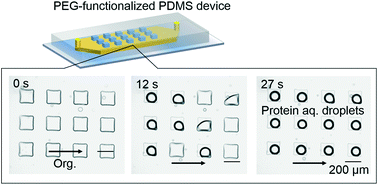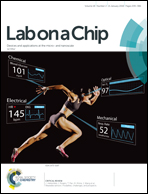Dynamic wettability of polyethylene glycol-modified poly(dimethylsiloxane) surfaces in an aqueous/organic two-phase system†
Abstract
We herein report the preparation of a surface that behaves in a hydrophobic manner but does not undergo protein adsorption in an aqueous/organic two-phase system. We found that polyethylene-glycol (PEG)-modified poly(dimethylsiloxane) (PDMS) exhibits hydrophobic properties when the surface is immersed in an organic solution, while the PEG moiety prevents protein adsorption on the PDMS surface in an aqueous solution at high protein concentrations due to the dynamic behaviour of the PEG moiety. As such, we demonstrated the in-well droplet formation of an aqueous solution containing a high protein concentration. In addition, to demonstrate the feasibility of this method in single cell analyses, a droplet array of a liquid medium containing 10% fetal bovine serum and HeLa cells was formed. The preparation of a droplet array using our PDMS-PEG surface to promote in-well droplet formation avoided the use of flow control equipment and complicated microstructures. We therefore expect that the dynamic wettability of our reported surface will be applicable in single cell and biochemical analyses, such as protein characterisation using crystallography or immunoassays.



 Please wait while we load your content...
Please wait while we load your content...